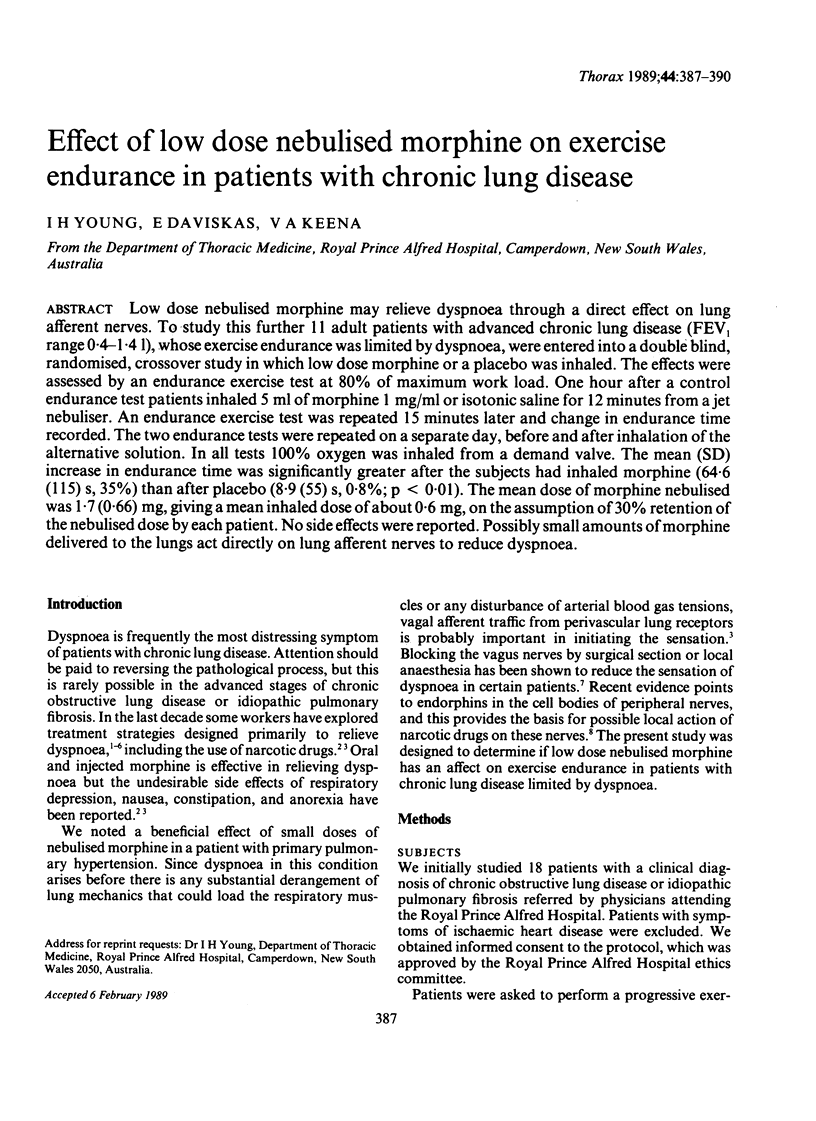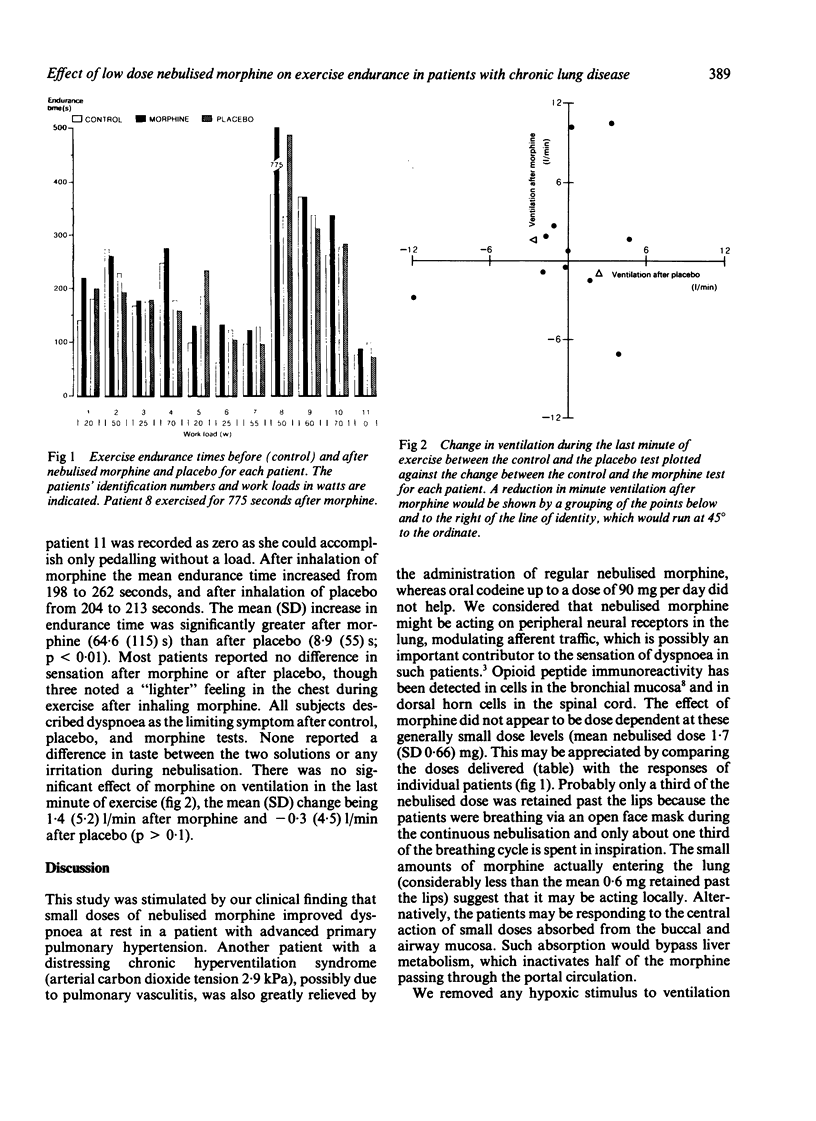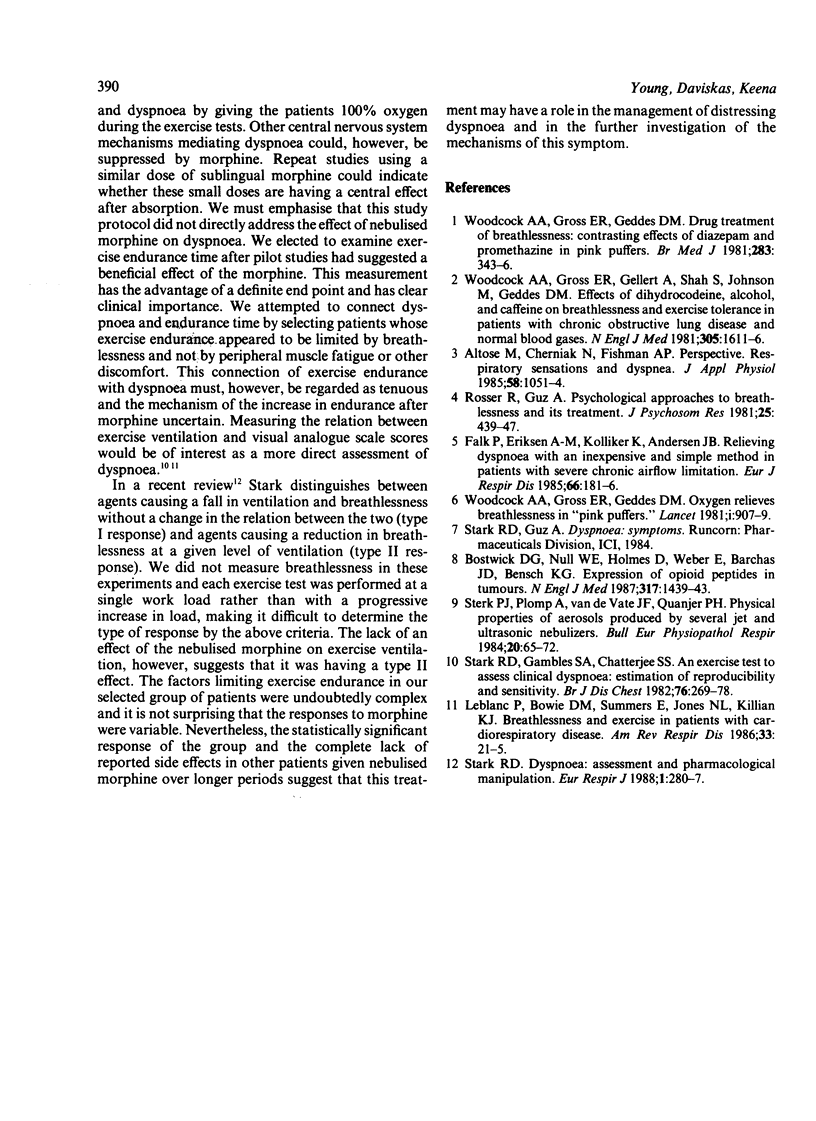Abstract
Low dose nebulised morphine may relieve dyspnoea through a direct effect on lung afferent nerves. To study this further 11 adult patients with advanced chronic lung disease (FEV1 range 0.4-1.41), whose exercise endurance was limited by dyspnoea, were entered into a double blind, randomised, crossover study in which low dose morphine or a placebo was inhaled. The effects were assessed by an endurance exercise test at 80% of maximum work load. One hour after a control endurance test patients inhaled 5 ml of morphine 1 mg/ml or isotonic saline for 12 minutes from a jet nebuliser. An endurance exercise test was repeated 15 minutes later and change in endurance time recorded. The two endurance tests were repeated on a separate day, before and after inhalation of the alternative solution. In all tests 100% oxygen was inhaled from a demand valve. The mean (SD) increase in endurance time was significantly greater after the subjects had inhaled morphine (64.6 (115) s, 35%) than after placebo (8.9 (55) s, 0.8%; p less than 0.01). The mean dose of morphine nebulised was 1.7 (0.66) mg, giving a mean inhaled dose of about 0.6 mg, on the assumption of 30% retention of the nebulised dose by each patient. No side effects were reported. Possibly small amounts of morphine delivered to the lungs act directly on lung afferent nerves to reduce dyspnoea.
Full text
PDF



Images in this article
Selected References
These references are in PubMed. This may not be the complete list of references from this article.
- Altose M., Cherniack N., Fishman A. P. Respiratory sensations and dyspnea. J Appl Physiol (1985) 1985 Apr;58(4):1051–1054. doi: 10.1152/jappl.1985.58.4.1051. [DOI] [PubMed] [Google Scholar]
- Bostwick D. G., Null W. E., Holmes D., Weber E., Barchas J. D., Bensch K. G. Expression of opioid peptides in tumors. N Engl J Med. 1987 Dec 3;317(23):1439–1443. doi: 10.1056/NEJM198712033172304. [DOI] [PubMed] [Google Scholar]
- Falk P., Eriksen A. M., Kølliker K., Andersen J. B. Relieving dyspnea with an inexpensive and simple method in patients with severe chronic airflow limitation. Eur J Respir Dis. 1985 Mar;66(3):181–186. [PubMed] [Google Scholar]
- Leblanc P., Bowie D. M., Summers E., Jones N. L., Killian K. J. Breathlessness and exercise in patients with cardiorespiratory disease. Am Rev Respir Dis. 1986 Jan;133(1):21–25. doi: 10.1164/arrd.1986.133.1.21. [DOI] [PubMed] [Google Scholar]
- Rosser R., Guz A. Psychological approaches to breathlessness and its treatment. J Psychosom Res. 1981;25(5):439–447. doi: 10.1016/0022-3999(81)90066-0. [DOI] [PubMed] [Google Scholar]
- Stark R. D. Dyspnoea: assessment and pharmacological manipulation. Eur Respir J. 1988 Mar;1(3):280–287. [PubMed] [Google Scholar]
- Stark R. D., Gambles S. A., Chatterjee S. S. An exercise test to assess clinical dyspnoea: estimation of reproducibility and sensitivity. Br J Dis Chest. 1982 Jul;76(3):269–278. [PubMed] [Google Scholar]
- Sterk P. J., Plomp A., van de Vate J. F., Quanjer P. H. Physical properties of aerosols produced by several jet- and ultrasonic nebulizers. Bull Eur Physiopathol Respir. 1984 Jan-Feb;20(1):65–72. [PubMed] [Google Scholar]
- Woodcock A. A., Gross E. R., Geddes D. M. Oxygen relieves breathlessness in "pink puffers". Lancet. 1981 Apr 25;1(8226):907–909. doi: 10.1016/s0140-6736(81)91612-3. [DOI] [PubMed] [Google Scholar]
- Woodcock A. A., Gross E. R., Gellert A., Shah S., Johnson M., Geddes D. M. Effects of dihydrocodeine, alcohol, and caffeine on breathlessness and exercise tolerance in patients with chronic obstructive lung disease and normal blood gases. N Engl J Med. 1981 Dec 31;305(27):1611–1616. doi: 10.1056/NEJM198112313052703. [DOI] [PubMed] [Google Scholar]



